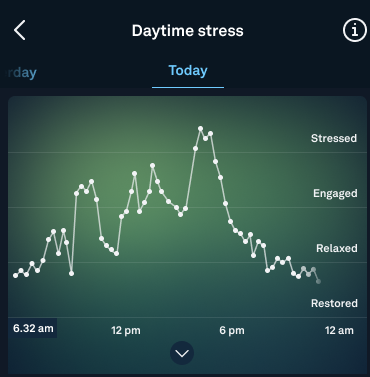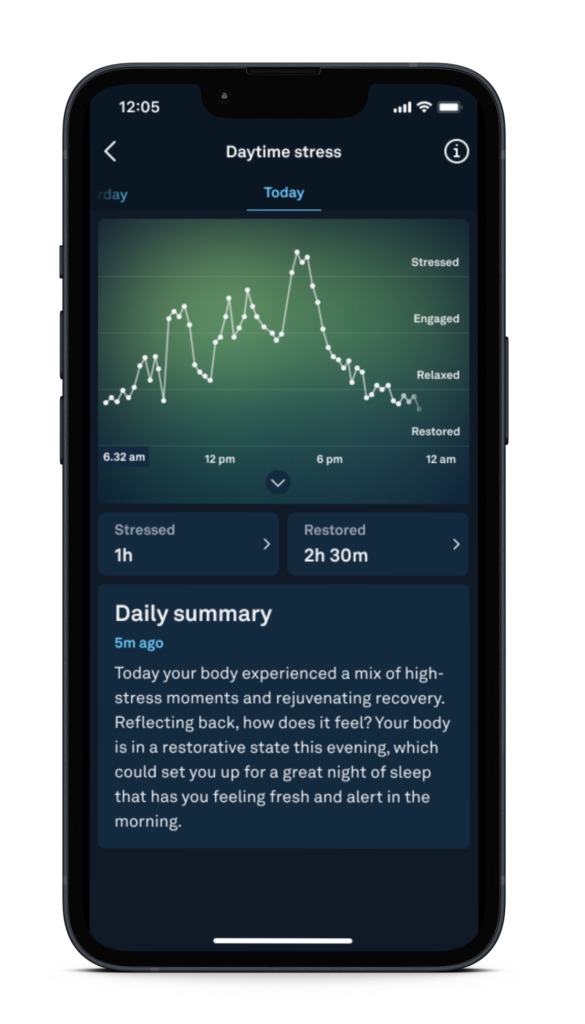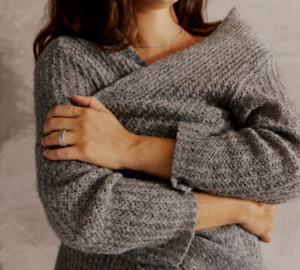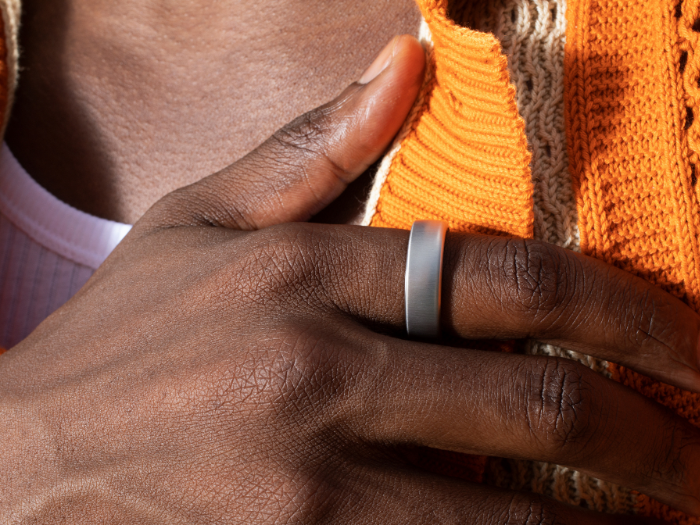Oura’s new Daytime Stress feature was created to empower members to learn how to better handle periods of physiological stress, benefitting their health and resilience in the long run.
To better understand how the Daytime Stress feature works and how Oura members can use it to support their health, keep reading to hear from several of the key players who worked on this product.
LEARN MORE: Track, Understand, and Manage Your Stress With Oura
The Next Frontier in Health Tracking
Building on the state-of-the-art sleep tracking technology and readiness assessments that Oura is known for, Oura recently introduced a new feature that tracks multiple biometrics to assess physiological stress.
“This feature symbolizes a revolution in how we think about stress and how we pay attention to what our bodies experience day to day,” says Sofia Strömmer, PhD, Behavioral Scientist at Oura. “A big part of health is understanding the signals our bodies are giving us, and learning from them.”
“Although Oura already measured recovery during the night, we can now get more detailed information about the variation of the sympathetic and parasympathetic nervous system during the day,” notes Mari Karsikas, PhD, Head of Product Science at Oura. “The Daytime Stress feature was a very logical next step.”
Why is it helpful to track your stress levels? As Strömmer puts it:
“It’s beneficial to be able to see and reflect on what things in life cause physiological stress, or activation, in your body. It allows you to understand when you need to take time to let your body recover — even if the stress comes from something that feels good, like socializing. Taking care of our bodies allows us to feel and operate better in the long run.”
How Stress Works
“When most people consider stress, they view it as a condition of the mind,” says Emmi Antikainen, Data Scientist at Oura. “But in reality, stress manifests physiologically, as well as mentally.” That’s why people typically associate stress with sweaty palms or a racing heart rate — even when they’re not tracking it.
In your body, the stress response is an evolutionary survival mechanism. It sends a rush of adrenaline, raises your respiration rate, and raises your heart rate in order to provide energy and oxygen to your body.
The goal of the stress response for our ancestors? To prepare to fight or flee a major threat. However, in the modern world, our stressors look different — it’s more like sitting in traffic, work deadlines, hectic travel, or arguments with loved ones. In some more long-term cases, this response is perpetually activated, pushing you into a state of chronic stress.
But stress isn’t all bad. Contrary to popular belief, stress can be productive. It can even be healthy and even make you more resilient in the long run — as long as you balance it with proper recovery. For example, a tough workout can elevate your stress, but it also induces long-term positive cellular adaptations.
READ MORE: Reframing Stress: The Difference Between “Bad” and “Good” Stress
How Does Oura Measure Stress?
 Throughout the day, Oura measures key biometric data points including your heart rate, heart rate variability (HRV), motion, and body temperature. With these data points, the Oura algorithm can create an accurate picture of your daily stress levels, says Antikainen. So when you’re awake and moderately stationary, Oura will be tracking your stress levels.
Throughout the day, Oura measures key biometric data points including your heart rate, heart rate variability (HRV), motion, and body temperature. With these data points, the Oura algorithm can create an accurate picture of your daily stress levels, says Antikainen. So when you’re awake and moderately stationary, Oura will be tracking your stress levels.
HRV is widely used as a standard method of assessing autonomic nervous function. Yet, in addition to HRV, Oura monitors changes in your heart rate, motion, and skin temperature to measure physiological all-cause stress responses.
“The physiological changes that happen in the body as part of the fight or flight stress response can be measured by Oura,” Antikainen explains. “On the Daytime Stress graph, you will be able to see when Oura detects physiological stress, giving your body a voice.”
Plus, Oura’s algorithm gets to know you as an individual. “Oura’s algorithm learns your personal baselines to help you understand your body’s responses to stressors and how you can embrace and balance stress and recovery over time,” Antikainen says. “The algorithm also adapts if your baselines change (e.g. due to aging) to give you actionable insights at all times.”
Here’s a deeper look into how each of these data points may change when your stress response is activated.
| Biosignal | Your Body’s Stress Response | How It Shows up in Oura Data |
| Heart rate | The endocrine glands release adrenaline and noradrenaline into the bloodstream, which then bind to receptors in the heart. When stimulated, these receptors increase your heart rate. This carries more oxygenated and nutrient-rich blood to your vital organs and muscles, helping you prepare to fight or flee the stressor. | Higher heart rate |
| HRV | When your sympathetic nervous system dominates, parasympathetic vagal activation lowers, and the time between each heartbeat becomes more stable and predictable. When you’re in a state of relaxation, it increases heart rate variability. In a state of stress, it increases heart rate regularity, to increase alertness in order to fight or flee a stressor. | Lower HRV |
| Motion | Physical activity can induce stress. Your heart rate increases, and your demand for oxygen increases, making your body work harder. Additionally, stress hormones (cortisol and adrenaline) can make you more physically active. In contrast, when you’re relaxed, you tend to be more stationary. | Increase in movement and activity |
| Skin temperature | The stress hormones cause blood vessels to constrict or narrow in the peripherals (including your fingers), to focus blood flow to critical organs and muscles needed for the fight or flight response. The limited blood flow causes the temperature in your fingers to lower. | Lower skin temperature |
The Daytime Stress algorithm has been validated against other well-established solutions and by conducting surveys for users to study the alignment with their subjective estimation.
| Member Tip: We recommend wearing your Oura Ring on the index finger for performance and accuracy. If you’d prefer another, the middle and ring fingers can work as well. And make sure it fits snugly — if your ring is too loose, it can impact the quality of the readings, and prevent the algorithm from accurately tracking your stress. |
LEARN MORE: HRV and Stress: What HRV Can Tell You About Your Mental Health
Commonly Asked Questions About Oura’s Daytime Stress Feature
1. What’s the Difference Between Physiological vs. Psychological Stress?
Stress is often perceived as a condition of the mind, but stress affects both the mind and the body. That’s how Oura can detect stress — through monitoring changes in your body that are associated with stress.
Psychological stress is mental — examples could include social anxiety, a lack of social support, excitement about an upcoming event, relationship problems, or stress over work deadlines.
Physiological stress is the stress experienced by our body. This is what Oura can detect, by measuring the effects of the changes in your nervous system.
The stress you see in your Oura App is a sum of external physical stressors (such as training, alcohol, sauna, or medication), internal physical stressors (like burnout, PMS, or pregnancy), and psychological stressors,” Karsikas explains. The reason: Your body doesn’t know the difference between physiological and psychological stressors. It’s all processed the same, and it all presents the same in your biometrics.
In other words, Oura’s telling you how stressed your body is due to a number of factors, both external and internal.
As Strömmer says:
“The societal narrative is often focused on psychological stress – the stress we experience and often weighs us down. Understanding that stress is physiological – an activation state of the body – is key. This perspective can give us the tools to ensure we have both stress and recovery in our daily lives, and we can use that physiological activation to our advantage.”
2. Why Do I See Stress Levels Rise Even if I Don’t “Feel” Stressed?
Oura members may notice that they are often in a state of elevated stress, with more time spent in a Stressed than a Restored state. This can be disconcerting, particularly if you don’t feel stressed – but don’t assume the worst.
The reason: Physiological markers of stress can present even if you don’t feel stressed. For example, you might be relaxing at the dinner table and drinking a glass of wine, but Oura picks up on changes caused by alcohol, such as an increased heart rate. Alcohol, in particular, also increases cortisol secretion and can be dehydrating, causing stress to appear in your Oura App.
Stress can also be triggered by factors beyond your control, including physical conditions such as pregnancy or having an infection, as well as environmental factors like altitude, noise, or humidity.
| Member Story: Udo S. was surprised to see that his stress on Oura was elevated after drinking alcohol, despite feeling relaxed. He connected this to poor quality sleep, and decided to limit his alcohol intake as a result. |
3. What Can I Do When Stress Levels Rise?

“Every person experiences stress and has to try and understand it and figure out how to deal with it. This feature is about helping people find the optimal stress-recovery balance,” says Strömmer.
While you can’t always reduce your exposure to stress, you can try to prioritize recovery – and understand what helps you best enter a Relaxed or Restored state.
You may think that watching reality TV with a glass of wine is relaxing, but notice that you’re still in a state of stress. Having this insight is highly advantageous. While you don’t need to (and can’t) completely cut out all stress-inducing habits, you may choose to experiment with other ways to wind down, like reading a book.
“The important thing is to reflect on the things that show up on the curve as Relaxation or Restorative Time and ensure you have enough of that in your days to balance out the stress,” Strömmer concludes.
4. So, Is All of My Stress Bad?
The answer here is a resounding no. “It’s a misconception that a life without stress is better,” says Strömmer. In fact, studies have shown that people with no stress tend to be older, unmarried, and often unemployed.
“Society has framed stress as something evil and dangerous, and we have come to fear and loathe it, having a constant vigilance to try and fight it off,” she explains. “But stress is not something that is wholly bad—it’s a vital part of life. We don’t want members to think they need to avoid bouts of physiological stress. It’s just long-term, chronic stress that needs to be managed.”
And remember: stress isn’t always caused by a negative experience – it can also be triggered by excitement or exercise, socializing or sauna. These types of stress can be considered “eustress” – a type of positive stress coming from beneficial strain.
Another example is hormetic stress, a type of stress that can improve your performance and enhance your resilience — for example, using a cold plunge or breathing exercises.
READ MORE: 10 Simple Breathing Exercises for Sleep and Relaxation
Looking Forward
Oura is constantly developing features that help to paint a holistic picture of each individual’s health. Resilience, our new feature coming this winter, will give you an insight into how you’re balancing your stress so you can understand how to leverage stress for the better.
Having access to stress, sleep, and other health insights can inform your daily choices and put the power for positive change in your hands.
About the Oura Experts
Emmi Antikainen is a Data Scientist at Oura, who is currently finishing her PhD in signal processing and machine learning, with a thesis focused on health data analytics. Additionally, she has a master’s degree (MSc) in computational physics. Before joining Oura, she was a research scientist at VTT Technical Research Centre of Finland, developing algorithms for human sensing and health data applications.
Mari Karsikas, PhD, is the Head of Product Science at Oura. She has more than 20 years of experience in research and product development based on patient and health data of hospitals and health technology companies. She has a Doctor of Technology degree focused on intelligent systems and biosignal processing. In her free time, she loves kite skiing and arctic adventures in northern Finland, where she lives.
Sofia Strömmer, PhD, is a behavioral scientist at Oura. She is from Finland, but lived in the UK for 16 years before moving back to join Oura. She is a Chartered Psychologist and has a PhD in Psychology focusing on the motivational determinants of exercise behavior. Her area of expertise is in motivational aspects of health behavior change and how motivation for health behaviors arises and is maintained. Before joining Oura, Sofia worked as a researcher at the Medical Research Council at the University of Southampton.










